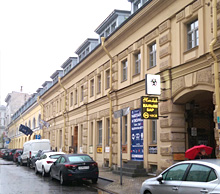In the process of preparing the post about the Czech city of Mlada Boleslav, it turned out that he was not so sad, as I remember, and it was not very noteworthy at all. Yes, the castle there is really gray and boring, but the main city square is good, and there are also dancing fountains at night! Chumova fountain on urban …
Without kewood
LIVE IN LIVEJOURNAL With a third-party service, you accept the terms of the LiveJournal User Agreement
November 6th, 2016
Chumova fountain on the city square!
Mlada Boleslav is located 50 km north-east of Prague. Population of about 44 thousand inhabitants. The city is famous, first of all, here by the ŠKODA car plant, in the museum of which we specifically and arrived (the museum was closed for reconstruction, so the exhibits had to be found in the hangar, but this will be a separate post).
Mlada Boleslav was founded in the second half of the X century Czech Prince Boleslav II pious as the royal castle over the river Yizer. By the time of his foundation near Prague, there was already a castle called Boleslav, so the new castle was named Mladá Boleslav. Thanks to the favorable location on the way from Prague to Prague and Brandenburg Mlada Boleslav developed rapidly and in 1334 he received the right of the city, despite the fact that at the end of the XIII century, as a result of the local police, the castle was destroyed and burned. In those days, the city was owned by the nobled of Michalovic. With them in the XIV century, the city apparently flourished; Then there was a triangular market square with houses (then mostly wooden) wealthy citizens.
Gusite wars in the XV century led the city in decline, all monasteries in the surrounding area were destroyed. In 1469, the city went to the possession of Jan Tovačovský z Cimburka, who immediately confirmed the city all previously granted rights. He married Johanka's pan from the local kind of Krajíři Z Krajku, who bowed him to his faith of the Czech brothers (the branch of Protestantism formed by the followers of the Gusitsky movement). As a result, at the end of the 15th century, Czech brothers occupied the restored Minister Catholic church for their prayers. And after the death of Yana, the owner of the city was the genus of his wife, which further strengthened the position of the Czech brothers in the city, and in 1518 their typography was founded here. The city gradually became the religious center of the Czech brothers and even gained the nickname "Bratsky Rome".
In 1554, the Czech of the Czech brothers under the leadership of the Italian architect Matteo Borgorelli was completed. Then they started building the old Renaissance Town Hall, which lasted five years. And in 1566 the construction of the Church of the Assumption of Our Lady (Kostel Nanebevzetí Panny Marie) was completed. In general, the XVI century was for the city a period of economic lifting, when he had suburb (Nové Město), the crafts developed, a distiller and a plumbing were built. A city castle was also restored.
In the 1600th year, Emperor Rudolf II bestowed Mlada Boleslav by the Rights of the Royal City.However, after the beginning of the thirty-year war, the city has declined; During hostilities, the castle and the suburbs were destroyed. Mlada Boleslav again experienced a rise only with the beginning of the industrial era: in the XIX century, several factories were built on the Yizer River, including textile, as well as vodka, brewery and sugar factories. In 1865, the first railway line was carried out in Mlada Boleslav. In 1895, Mechanic Waclav Lorin (Vaclav Laurin) and bookseller Vaclav Klement began production of Slavia bicycle, from which a motorcycle manufacturing plant was soon grew, and then the Laurin & Klement automaker is now known as Škoda auto.
View of the city's square and the Old Town Hall from the Cafe Terrace
The area is a strongly elongated triangle, most of the houses in which are cultural monuments of the Czech Republic. The bell tower of the church of St. Yana Nepomotsky is visible. The design in the lower left corner is the original fountain of Yizer, which I still show in different angles
Vinoteca "The Black Eagle" illustrating the Czech tradition to give homes their own names
Unfortunately, some historic buildings are launched and taken off with advertising signs (however, this is a shooting of 2012; since then everything could change)
Old Town Hall with Fountain
The dancing fountain is especially beautiful at night, well, the Town Hall Covered Sgrafito is most profitable for the day
A little more photos of the Old Town Square
We shot a room at its very end, overlooking the latemical houses of the XV century, rebuilt in the Renaissance, Baroque and Classicism

The modern fountain of Yizer, named after the river, appeared on the square only in 2010 in the framework of the Revitalization of the city center (apparently, on the spot is so characteristic of the Czech city of parking). The fountain has a classic part with jets, periodically beating from under ground with different intensity, as well as an unusual stainless steel cascade in the form of a river stream with teenagers sculptures

Catholic church of the Assumption of Our Lady, laid down in 1406 and ended in a century and a half later, with a baroque facade of 1702
Outside the center of the house, they are more or less newly new, since during World War II, Mlada Boleslav has undergone significant destruction: there were factories that have been supplied by the Reich industrial products.
Gymnasium of Czech brothers: At the heart of the Renaissance Building of the XVI century building, which was rebuilt into school in 1785. Nearby – Baroque Sculpture of St. Anne
City Theater, built in 1906-09 in the style of sesses
On the territory of the castle now there is a museum where we did not go
From the center of the city, the castle does not make a pleasant impression and does not have to visit
But I could not refuse himself the pleasure of shooting dancing fountains at night!


On the right, a marine pillar is clearly visible, he is a plague column – the work of early baroque, dated 1681

















